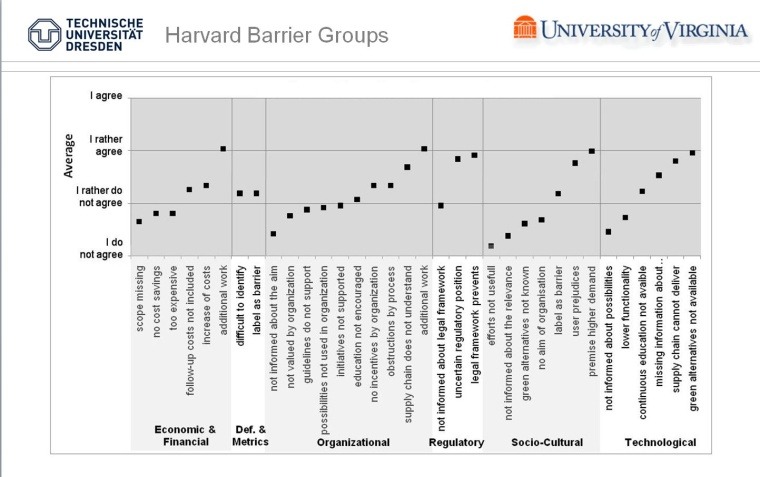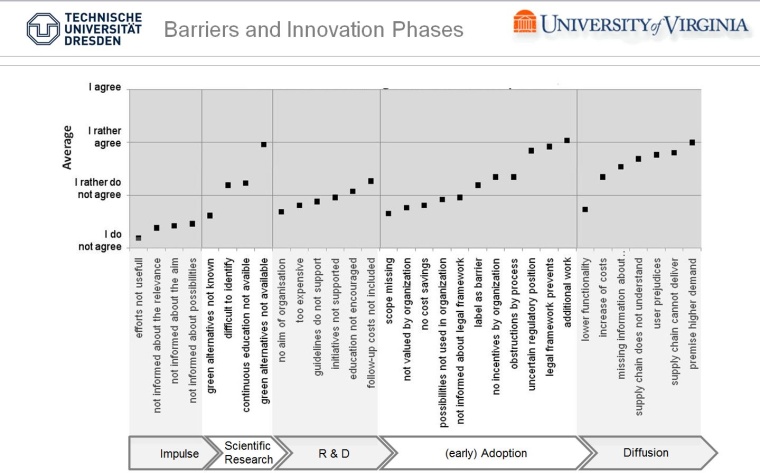Green Chemistry and Engineering



Proving the Value of Sustainability - Green chemistry and engineering, a promising and innovative approach toward sustainable chemistry, is not yet established. As every adoption process is obstructed by barriers, 70% of planned organizational change initiatives fail. Thus, the minimization of disruptions is decisive.
We present major barriers to green chemistry and engineering derived both from expert interviews and a survey. Barrier analysis is a powerful tool for the assessment of every company. Based on its results, companies can derive strategies for overcoming barriers.
The transition to a sustainable chemical industry requires radical technological innovation for new processes and products. This new paradigm implies added value from the use of chemicals without adding new risks to our society or transferring risk to future generations. Environmentally benign chemical synthesis - better known as green chemistry - is the most basic concept among a list of promising concepts to transform sustainable chemicals into action.
But green chemistry is not yet established in the chemical industry. The implementation of green chemistry can increase corporate value, mitigate a company's risk and strengthen long-term competitiveness. So why does the implementation of green chemistry lag behind expectations?
The focus of this article is to identify factors - known as barriers - related to the implementation of green chemistry in industrial chemistry that may hamper, decelerate or even block its adoption. As every adoption process is obstructed by barriers, especially such essential innovations are affected. We have analyzed major barriers to the implementation of green chemistry.
If barriers are not surmounted, green chemistry might fail and it might become a threat for the company. The discovery and consideration of as many barriers as possible is supposed to decrease vulnerability and increase resilience and, therefore, ensure the survival of the company.
Six Barriers to Green Chemistry and Engineering
In order to identify and evaluate these barriers, we analyzed literature and conducted an explorative survey. Primarily we focus on the six barrier categories identified at the Harvard workshop "Overcoming the Challenges to the Implementation of Green Chemistry":
- Economic and financial: The chemical industry is a well-established, mostly capital-intensive industry. There is a high investment barrier.
- Regulatory: Current regulation focuses on reducing risk through reductions in exposure while green chemistry promotes the reduction of inherent risk by reduction of hazard. Changes to more benign processes are inhibited by cost-intensive, control-oriented regulation.
- Technological: The number of disciplines involved in green chemistry is high and, accordingly, so is the number of "scientific" languages. The lack of appropriate training of chemists, including the ability to think on a more global or system level, has emerged as an important barrier.
- Organizational: The "promoters by know-how" - e.g., the chemist in research and development - are mostly not in a position of power. The "promoters by power" - e.g., the management executives - need an attitude toward the implementation of green chemistry to support it strongly enough.
- Sociocultural: Missing awareness within the different stakeholder groups can be a barrier to the implementation of green chemistry.
- Definitions and metrics: There is a lack of a consistent measurement for "green" chemical products or processes.
Barriers related to these identified classes might occur at different stages of the implementation process.
Methodology Of Barrier Analysis
Based on the barriers identified in this workshop, a questionnaire was developed to identify and assess those factors that may hamper, decelerate or even block green chemistry. The observation items were the perceived, i.e., subjective, barriers, as they embody risks, whereas an objectified measurement of barriers does not accomplish the same aim; it is perception that influences human behavior and not objective measures. The study was designed as a written web-based survey.
For the visualization of the results of the questionnaire, a barriers profile was chosen. It shall assist the organization in designating a starting point for a deeper analysis of the identified barriers and to generate strategies to overcome them. This assessment method uses the averages and spreads to identify tendencies for possible barriers and to evaluate their relevance.
Through this method it can be assessed whether potential barriers are perceived as barriers (the higher the average, the bigger the perceived barrier) as well as whether different views exist about barriers (the bigger the spread, the more different the perception of a barrier). This analysis aims to determine first trends (e.g., all interviewees perceive one barrier almost identically) and to identify starting points for the assessment of causes for barriers (e.g., strongly differing views on barriers suggest a need to ascertain the reasons behind those differences).
Results And Discussion
We matched our results with the six major barrier groups obtained as a result of the Harvard workshop. The barrier statements were sorted according to the Harvard groups by investigator triangulation, i.e., three persons classified the barriers independently and then discussed the results. Matching the barriers with the classification developed at the Harvard workshop, it can be seen that within each barrier group some prerequisites are already given, whereas others still have to be strived for. The results reveal that within each group (except the metrics and definition group) some barriers seem to be overcome, whereas others still have to be strived for.
To further analyze the causes of barriers to the implementation of green chemistry, the barriers were sorted along the innovation cycle. The innovation process was used because innovation is one of the main drivers for value in chemistry, and green chemistry solutions are innovations. That analysis shows a more differentiated picture than the analysis of the Harvard barrier groups in order to develop strategies for overcoming the barriers. Barriers seem to be perceived higher the later the stage of the innovation process. Activities to overcome barriers as sources for intangible risk should focus on the adoption and diffusion stage.
Value Of Green
Green chemistry as the most fundamental concept in sustainable chemistry has achieved a good awareness level. Yet implementation needs to be pushed forward. Activities to overcome barriers regarding the implementation of green chemistry should focus on the adoption and diffusion stage. While different strategies such as the stronger involvement of policies or the expansion of networks are advantageous, we plead for the necessity of involving green chemistry aspects into corporate decision calculus.
We argue that one aspect is the missing connection between green chemistry and the value of the company. Even though companies are persuaded by the concept of green chemistry and take an active role in the transition to a sustainable chemical industry, they will first ask for its contribution to the company's value. The primary issue from the company's perspective is that of economics.
"The chemical industry exists to make profits and products, in that order," according to Green Chemistry in Practice by Joseph J. Bozell. In other words, unless there can be shown a value, they will not choose the green path.
Acknowledgements
We are thankful for the valuable input from Professor Julie B. Zimmerman and Professor Paul Anastas of the Center for Green Chemistry and Green Engineering at Yale University. Especially we would like to highlight their advice for the questionnaire and provision of contacts for the survey.
Company
TU Techn. Univers. DresdenMünchner Platz 1 /3
01187 Dresden
Germany
most read

Relocation of Chemicals Production Footprint in Full Swing
A new Horváth study based on interviews with CxOs of Europe’s top chemical corporations reveals: The majority of board members expects no or only weak growth for the current year.

Pharma 4.0 – the Key Enabler for Successful Digital Transformation in Pharma
Part 1: Building a Business Case for Pharma 4.0

Q1 2025 Chemical Industry: Diverging Trends
The first quarter of 2025 highlights a continued divergence between the European and US chemical industries.

Lead or Lag: Europe’s AI Materials Race
How AI and Robotics are reshaping the race for materials discovery.

20 Years of CHEManager International
Incredible but true: CHEManager International is celebrating its 20th anniversary!











